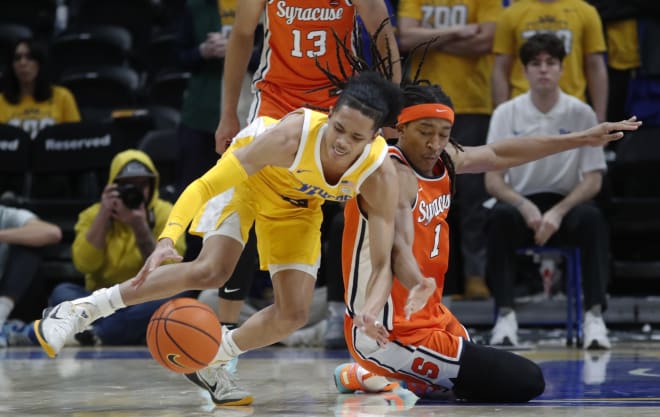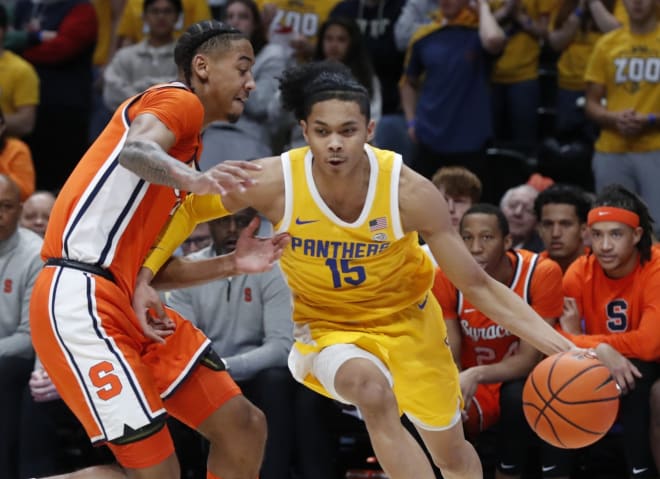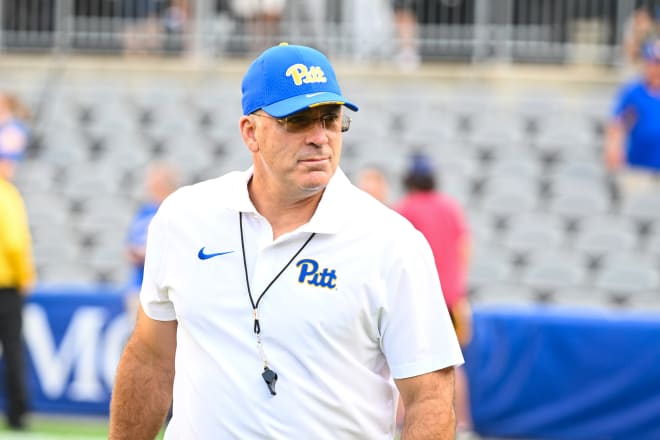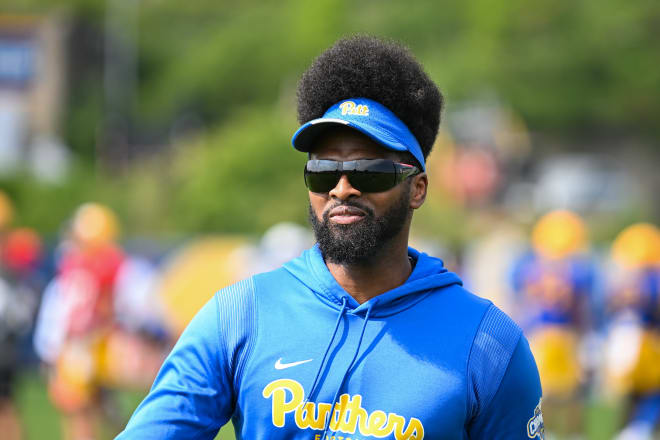The 3-2-1 Column: Hoops issues, football hires, transfers and more
MORE HEADLINES - PODCAST: The latest hoops loss, the new coaching hires and more | The Morning Pitt: What do we make of Narduzzi's newest hires? | In the film room: Likes and dislikes from the loss to Syracuse | Three-pointers: Reactions to the loss to Syracuse | 2025 OL prospect from Georgia adds a Pitt offer
In this week's 3-2-1 Column, we're thinking about the state of Pitt hoops, the newest football hires and a lot more.

THREE THINGS WE KNOW
A need for leadership
If this isn’t a downward spiral, it will do until the downward spiral gets here.
You know the details: Pitt has lost four of its last five games, all ACC contests that have put the Panthers at 1-5 in conference play as they hurtle toward the midpoint of the league season.
It was one thing to lose to North Carolina and Duke, the ACC’s surest bets for the NCAA Tournament, but when they absolutely needed a win on Tuesday night against a Syracuse team that seems to be vying for the same spot in the middle of the ACC, the Panthers fell flat, making just two field goals in a 10-minute span in the first half and never recovering.
Now they’re about to go to Cameron Indoor tomorrow for what feels like it will be another ACC loss, but at this point, it’s hard to say any game doesn’t feel like a potential or even likely loss.
Maybe that’s just the sting of the Syracuse game talking, but it sure feels that way with Pitt right now.
There are many ways to lose, of course, and the Panthers have experienced quite a few of them this season. The loss to UNC was not the same as the loss to Duke, and the second loss to Syracuse was not the same as the first.
In this most recent defeat, Pitt lost because the offense completely disappeared for a quarter of the game. The Panthers were up six with 10 minutes left in the first half; by the time the teams went to their respective locker rooms for halftime, the Orange had an 11-point lead.
How did Pitt get outscored 23-6 in those 10 minutes? Syracuse made a bunch of shots, of course, but more to the point, the Panthers simply didn’t.
They were 2-of-12 from the field in that span, and while they grabbed five offensive rebounds on those 10 misses, none of them resulted in made baskets.
I’ve thought a lot about that stretch of the game in the last few days, and I keep coming back to the same conclusion:
Pitt doesn’t have a player who can make a shot when a shot needs to be made. I think the Panthers had two of them last year in Jamarius Burton and Nelly Cummings. When the opponent was on a run or Pitt’s offense was slumping, those two - especially Burton - were really good at stepping up and getting something, just to stem the tide or provide a spark.
That’s what Pitt needed in those 10 minutes. The Panthers needed somebody to make a shot, just to change the direction of the game. But possession after possession, nothing went in.
And Pitt’s leading scorers were particularly rough in that stretch. Blake Hinson missed three shots and Bub Carrington missed four. Put that in the larger context of the game, where Hinson and Carrington combined to shoot 4-of-27 (with Carrington missing all 10 of his shots), and you’ve got a big problem that’s identifiable:
Pitt needs a leader on the court. Not somebody who can rally the troops or lift up a struggling teammate. Not somebody who can communicate or keep the team together in a huddle.
Pitt needs somebody who can step up and make a shot when a shot is needed. Pitt needed Hinson and/or Carrington to make a shot in that 10-minute stretch. That was ultimately when the game was decided, and the only player who put the ball in the hoop during those 10 minutes was Will Jeffress.
That can’t happen. It just can’t. Your top players have to step up there. Your leading scorers have to lead the scoring.
There’s a difference between being the leading scorer and being a leader; the two often overlap, but they are not the same. And while I think this Pitt team has good leadership off the court, the Panthers need someone to be a leader on the court in the moments when leadership is needed most.

Lowe’s emergence
Let’s not be too dark about the state of Pitt hoops. No, the overall picture doesn’t look great. And yes, the Panthers are on their way to Durham for a rematch with a team that thrashed them in Pittsburgh just last week.
That doesn’t bode well.
But it’s not all bad. In fact, I would say that there’s at least one really good storyline developing, and it’s the emergence of Jaland Lowe.
I don’t need to tell you what you already know, but Lowe has been really good since the full-time ACC schedule kicked in. Over the last five games he is averaging 11.4 points, 2.8 rebounds and 2.8 assists and shooting 41.2% from the field while playing 26.2 minutes per game.
For comparison, Hinson is averaging 12.8 points per game on 28.4% shooting in the last five games; Carrington is averaging 12.6 points and shooting 33.8%.
| Player | FG | 3FG | PPG | RPG |
|---|---|---|---|---|
|
Blake Hinson |
19/67 (28.4%) |
11/45 (24.4%) |
12.8 |
4.2 |
|
Bub Carrington |
22/65 (33.8%) |
8/33 (24.2%) |
12.6 |
5.6 |
|
Jaland Lowe |
21/51 (41.2%) |
5/11 (45.5%) |
11.4 |
2.8 |
So it’s not a stretch to say that Lowe has been Pitt’s best player in the last five games. And he was really good in the second half on Tuesday night. In fact, he seemed to be the only player really keeping the Panthers in the game, and that’s not an exaggeration. Lowe scored 16 of Pitt’s 32 second-half points and single-handedly got Syracuse’s lead into single digits twice.
The first time he did it, Lowe drove to the basket for a layup and followed that with a pull-up jumper that cut the lead to eight points with 14 minutes left to play. 10 minutes later, he went coast-to-coast for a layup and converted a pair of and-1’s to get it to nine.
Those were the only times in the second half when Pitt trailed by less than 10, and since nobody else on the team really contributed, they ended up being the only times the Panthers seemed like they could make the game competitive.
What stood out to me the most about Lowe was not just his aggressiveness - although that was key - but also his ability to perceive the situation. When he saw an opening to drive to the basket from his left side, he took it quickly and decisively (and usually finished). And when the opening wasn’t there, he often found ways to set up his teammates.
By the time the game ended, Lowe had either scored or assisted on 10 of Pitt’s 13 second-half field goals. He really was the Panthers’ lone source of offense after halftime, and with Hinson and Carrington shooting a combined 2-of-13 in the final 20 minutes, it was very much needed.
On Tuesday night, Lowe’s play didn’t lead to a win for Pitt, but I’m going to look on the bright side:
If Hinson and Carrington get back on track, then Lowe’s emergence will give the Panthers three legitimate scoring options, and that sure seems important for a team that has scored less than 60 in its last three home games.

The most surprising transfer portal moves
…Or non-moves, as it were.
For whatever reason, I never really dove into this too deeply when it happened, but I was thinking this week about Pitt’s interactions with the portal this offseason - the players Pitt lost to the portal and the players Pitt gained from the portal.
Ands I have to say, the most surprising portal move of all wasn’t getting a four-star quarterback from Alabama’s scout team. It wasn’t landing a pair of former highly-rated defensive linemen. And it wasn’t losing a couple defensive players who were all but guaranteed starting jobs.
It was losing two players to the portal, only to have them return a few weeks later.
I’m talking about Brandon George and Nate Temple. George went into the portal on Nov. 27, two days after the regular-season finale at Duke. Temple announced his move to the portal two days later.
On Dec. 10, both George and Temple announced that they were leaving the portal and returning to Pitt for one final season.
I have to say, I did not see that coming.
I wasn’t too surprised when they went into the portal in the first place. Both have one year of eligibility left, and it’s becoming fairly common for players to head elsewhere to play that final year (especially if the coaches are ready to move on to the next generation of players at their positions).
So that part wasn’t a surprise. But coming back? That one caught me off-guard.
It wasn’t so much that I was surprised to hear that maybe the transfer market wasn’t quite as hot for George and Temple as they expected it to be. Rather, it was a surprise that they were welcomed back. I don’t think there were any hard feelings about George and Temple going into the portal, but Pat Narduzzi doesn’t strike me as the type to bring back players who left.
Once you’re gone, you’re gone - that’s the mindset I image Narduzzi taking. I’ve heard stories of players telling coaches, “I’m probably going to stay, but I want to go into the portal and see what opportunities (scholarship and otherwise) are out there.” I’ve even heard of one player - not at Pitt - tell his head coach that he wanted five days in the portal and then he would decide if he was coming back to the coach’s school.
The head coach declined, and I imagine Narduzzi would react the same way.
But he was willing to take George and Temple back, and I’m still kind of surprised by it.
It’s not that George and Temple don’t have value. George will be useful for the middle linebacker position; I think some of the younger players could project there, but George has more experience. And while Temple hasn’t produced a whole lot, he’s a “program guy” who has been around a long time; it’s not a bad thing to have guys like that in the locker room.
No, it’s mostly just about Narduzzi and his willingness to take them back. Narduzzi strikes me as very much a “circle of trust” kind of guy, and when you break that circle, it’s really, really hard to get back in.
I guess people can still surprise you sometimes.

TWO QUESTIONS WE HAVE
What do we make of the new hires?
Transfers weren’t the only personnel moves for the Pitt football program this offseason. Narduzzi also made four changes to the coaching staff, virtually overhauling the entire offensive side of the ball by firing coordinator Frank Cignetti, line coach Dave Borbely, running backs coach Andre Powell and tight ends coach Tim Salem.
That’s a lot of turnover, and Pitt finally announced the replacements for Borbely, Powell and Salem this week.
For the offensive line, Narduzzi hired Jeremy Darveau. For running backs, he is bringing in Lindsey Lamar. And for tight ends and special teams coordinator (which Powell oversaw), the hire is Jacob Bronowski.
It’s true: those are three people who have never been in my kitchen. And I can’t say I was very familiar with any of them prior to their names emerging as top candidates for those three jobs.
But I think I get the appeal with each of them, and I think I understand what Narduzzi was looking for in those three hires.
Bronowski is perhaps the most high-profile of the additions. He built his reputation as the special teams coordinator at Miami (OH) over the last two seasons, and while I am of the mind that we probably heap too much blame and too much credit on a special teams coordinator, there are some basic things that position can manage, and when Narduzzi’s press release emphasized how Bronowski’s special teams units were “extremely organized” and they “executed at a high level,” I think that’s telling about where he saw a need for improvement.
With Darveau, I think the obvious and direct appeal was his familiarity with Pitt’s new offense. Darveau was the offensive line coach at Western Carolina for the last two seasons, where he worked closely with play-caller Kade Bell, who just so happens to be Pitt’s new offensive coordinator.
If you’re looking to implement a new offense and have it work quickly, getting the offensive line coach locked in is a good place to start. Darveau knows the offense - knows how it works and what it needs - and that should allow him to hit the ground running as he works with the players.
Lamar played against Pitt at USF in the waning days of the Big East, and after coaching with the Bulls for four years, he moved to Howard and became the Bison’s offensive coordinator last season. So he’s joining the Panthers with play-calling experience and recent playing experience, which seems like a good combo.
And then there’s the matter of age. Darveau is the oldest of the three new hires, and he’s in his early 40’s. Bronowski and Lamar are both younger, as is Bell.
It’s a youth movement in Pitt’s offensive offices after nine years of older, more experienced coaches on that side of the ball.
I don’t think that’s entirely by accident.
Call it new blood or energy or just simply trying something different; whatever it is, Narduzzi has made a hard left turn on how he approaches the offensive side of the ball, from the direction of the offense to the age of his assistants.
After two years of bad offense, I can understand why he might be looking in a different direction, and I think the new hires - Bell included - reflect that.

Do you want good recruiters or good developers?
The answer, of course, is both.
But if you had to pick assistant coaches who were either good recruiters or good developers, then you would probably like to have a mix, with good recruiters at positions like running back, receiver and defensive back and good developers for the linemen and quarterbacks.
I’m defeating my own purpose here and finding ways around the question. So let’s try again.
If you told me, as a head coach, that the top two candidates for an open assistant position are defined primarily as one being a good recruiter and one being a good developer, then I personally would lean toward the recruiter.
Look, when it comes down to it, you need the dudes. The players make the coach, and it’s usually not the other way around. Andre Powell was the same guy when he coached Qadree Ollison and Darrin Hall to 1,000-yard seasons and Israel Abanikanda to a record-breaking campaign as he was during the more befuddling moments of 2021 and 2023.
Powell didn’t have occasional amnesia and forget how to coach the position; it was just that, in some years, he had better players than he did in other years.
The Jimmy’s and Joe’s outweigh the X’s and O’s, or so they say. And I think I tend to agree with that.
However, that’s not an entirely foolproof absolute, and that line of thinking is not without its caveats.
Particularly if you’re a school like Pitt.
For Pitt, and many other schools in the same tier of college football, the bulk of the roster will be made up of three-star recruits. We’re speaking generally here, but I don’t think I need too much evidence to convince you that the vast majority of high school players Pitt signs are three-star prospects.
15 of the 19 recruits in Pitt’s 2024 class are three-stars. 17 of 19 in 2023. 10 of 13 in 2022. 19 of 23 in 2021. 13 of 18 in 2020.
Do I need to continue?
And almost all of Pitt’s most accomplished players in the last decade (and more) have been players who were three-star recruits. Kenny Pickett. Jordan Addison. Israel Abanikanda. Jared Wayne. Calijah Kancey. Brandon Hill. Erick Hallett. So on and so forth back to Aaron Donald and beyond.
That’s where Pitt makes its living, and while we could spend entirely too much time debating whether guys like Addison were underrated, there’s a certain truth when you are building your roster with three-star guys:
You have to be able to evaluate the players and develop them.
That’s where the other side comes in. If we’re going to split assistant coaches into “recruiters” and “developers,” then the latter is more important if this is how your roster is built.
There’s probably a peripheral question here about the ceiling for Pitt recruiting. With a staff of the best recruiters in college football, could Pitt expect to fill its roster with four and five-star recruits? Or is there a limit to how many of those kinds of players you can realistically get here?
You need good recruiters to get good players, but if each school carries its own realities with regards to the caliber of player it can attract, then you have to adjust.
If Pitt is going to continue being the Three-Star All-Stars, it isn’t necessarily a bad thing; you can win a lot of games with those players in the great middle.
But you need to have coaches who can develop them.

ONE PREDICTION
2024’s leading receiver was on the team in 2023
This was inspired partly by a question in last week’s Mailbag and partly by the development that Pitt is likely to add another receiver from the 2024 recruiting class.
Overall, the receiver room in the South Side has already grown by three this offseason, and if the Panthers do add Shreveport (La.) Evangel Christian standout Tyreek Robinson, as expected, then the number will grow to four.
Incidentally, that’s still one less receiver than Pitt added last offseason, when the Panthers brought in four high school prospects and one transfer.
Still, four is a lot of guys to bring in; typically, adding that many players at a position like receiver would represent something of an overhaul. But I don’t think that’s the case here. I don’t think the receivers will look radically different on account of bringing in four guys.
In fact, my prediction here is that the top producers at receiver for 2024 were already on the roster in 2023.
I think Konata Mumpfield, Daejon Reynolds and Kenny Johnson are going to be the top three receivers on the team this season. I think they’ll be the starters and the primary options in three-receiver sets. And when the season ends, I think their names will be at the top of the stat sheet.
I wouldn’t be surprised to see something similar to 2023 where Mumpfield led the team in receptions and Bub Means led the team in receiving yards and touchdowns. Transposing that to 2024, I would look at Mumpfield for receptions and Johnson for yards and touchdowns.
(Of course, I continue to have high expectations for Gavin Bartholomew, but we’ll keep the focus on the receivers for the time being.)
This isn’t to say I don’t think the newcomers can make an impact. Raphael Williams intrigues me the most. He worked his way up from Division II (Tusculum) to FCS (Western Carolina) and then FBS (San Diego State, where he sat out last season). To hear him tell it, Williams had Power Five options when he transferred from Western Carolina, but those schools backed off upon learning that he would have to sit out a season.
So there’s some potential there.
Censere Lee is interesting, too. He certainly produced in 2023, catching 46 passes for 792 yards and eight touchdowns (every one of those numbers would have been a team high at Pitt last season), but we’ll see how that production translates to the FBS level.
And I can see what the coaches like in the high school guys, Robinson and Cameron Monteiro.
But when it comes down to it, I think the main targets will be those guys who have already been here. I think Mumpfield will continue being a really reliable receiver who slides under the radar for how good he actually is. I think Johnson will break out as a playmaker. And I think Reynolds will be really solid in the middle-depth parts of the field.
I don’t know if this team has a true No. 1 receiver, but I think it’s got enough talent at the position to make plays. Maybe the change in offensive system will open opportunities for newcomers like Williams and Lee to take advantage of, and I can’t entirely rule out contributions from redshirt freshmen Lamar Seymore, Israel Polk and Zion Fowler-El.
But I’m betting on Mumpfield, Johnson and Reynolds being the leaders this season.
